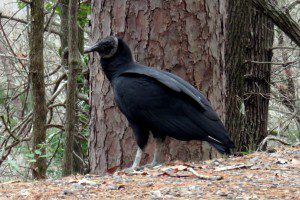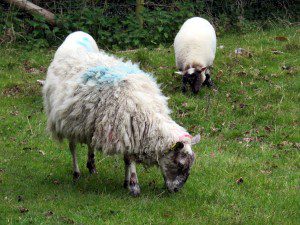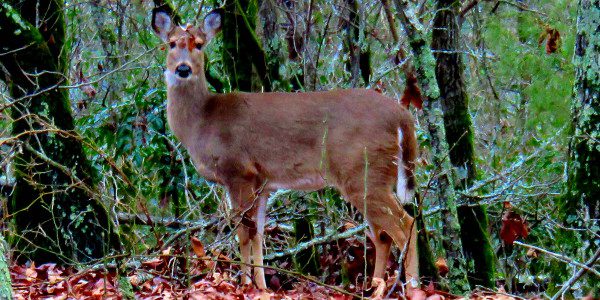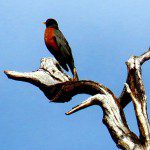Can we have an honest conversation about people and animals? Or, more precisely, a conversation about humans and other animals. You do know you’re an animal, right? Darwin pretty much shot the whole Imago Dei idea all to hell. The Egyptians were closer to the truth with their zoomorphic Gods. The members of the animal kingdom are far more alike than they are different, despite what we like to think. Our big brains, opposable thumbs, and capacity for language give us significant advantages over competing animals, but at the end of the day we’re just another species doing our best to overrun the carrying capacity of our environment.
But I think we need to talk about our relations with other animals.
We’ve heard about Harambe, the gorilla at the Cincinnati Zoo who was shot and killed after a 4-year-old child fell into his enclosure. There was the bison calf in Yellowstone National Park that had to be killed after tourists put it in their car because they thought it was cold and the herd refused to take it back. And also at Yellowstone, a woman narrowly escaped when an elk charged her as she approached it for a picture.
There are a lot of issues involved here. Why is a human life automatically considered more valuable than a non-human life, particularly when gorillas are an endangered species? Why do we keep wild animals in captivity? To help preserve endangered species? Probably a good thing. For the amusement of humans? Probably not. What are our obligations to other species, and to individual animals?
These are questions worth contemplating, but right now I want to talk about something simpler and more basic. I want to talk about the naïve, disrespectful, and downright dangerous ideas some of us have about wild animals.
We often hear that when wild animals lose their fear of humans, the animals end up dying. Sometimes they get hit by cars, but more frequently they become a dangerous nuisance and are killed pre-emptively. Sadly, the same is often true when humans lose their fear of wild animals – the animals end up dying.
 Part of me wants to blame this on the anthropomorphization of animals by Disney and the rest of the entertainment industry. But we’ve had stories of talking animals for thousands of years – as long as we’ve had stories. Animation makes a difference, but not that big a difference.
Part of me wants to blame this on the anthropomorphization of animals by Disney and the rest of the entertainment industry. But we’ve had stories of talking animals for thousands of years – as long as we’ve had stories. Animation makes a difference, but not that big a difference.
I think the main problem is that people in the West are growing up never encountering wild animals, or even farm animals. Domesticated farm animals are generally safe to be around, but they’re not pets and they’re not predictable. Chickens will peck you, rabbits will kick, and while cattle are generally docile, get between a cow and her calf or a bull and a cow and you can find yourself being charged by an angry animal that weighs ten times more than you.
Dogs are “man’s best friend” and have been domesticated for perhaps 15,000 years. But take ordinary dogs out of a supportive environment and they’ll kill people for no reason other than they can.
If people encounter wild animals, they see birds or squirrels, animals that keep their distance and are too small to pose much of a threat to humans. It’s rare for us to come across a wolf, a bear, a cougar, or even a snake in the wild.
Pagans see this with people who encounter animals and assume they’re bringing them some message. “I saw a crow today – I think the Morrigan is calling me.” Well, maybe, but crows live pretty much everywhere in North America. Did you ever consider that perhaps the crow is just a crow doing crow things? When you aren’t around animals you don’t get familiar with normal animal behavior and so you can’t recognize when an animal is doing something truly extraordinary.
Not only do we not fear animals that could harm us, we don’t respect them. We act like they’re here solely for our amusement. I like taking pictures of animals as much as any Nature lover with a camera, but we’re not paying them modeling fees – shoot from a safe distance and don’t harass them to get a better picture.

I am not a vegetarian and humans are far from the only animals that eat other animals for food. But there’s a huge difference between the reasons animals die and the ways in which they live while they’re alive. I grew up on a small farm and I’ve been on large farms. I’ve also seen factory farms. There’s a difference – traditional farms allow cows and chickens and pigs to live like cows and chickens and pigs. Factory farms that confine animals into tiny cramped conditions to maximize efficiency give them a miserable existence that no conscious being should have to endure.
With wild animals, we have a similar obligation to let them be who and what they are. One of the reasons we’re seeing an increase in incidents between humans and wild animals is that we’re encroaching on their habitats. As the human population increases and as we build homes further and further into areas that used to be wild, other animals are crowded out. As the climate changes, animals that have successfully lived in certain regions for hundreds or thousands of years are finding it harder and harder to stay there.
We need not decide that a gorilla’s life is worth the same as a human’s life to recognize that gorillas have rights inherent to all living beings. They have the right to be gorillas doing gorilla things and not simply amusements for humans – so do bison and elk, and lions and tigers and bears. They have the right to continue to exist, collectively as a species if not as individuals. If captive breeding has become necessary to insure the survival of a species, we have to ask ourselves why that has become necessary – and if the answer is that humans have encroached on their territory, how do we withdraw? If we have the resources to bring gorillas from central Africa to Cincinnati, do we not also have the resources to make it easier for the people in central Africa to give the gorillas the space they need?
Can we do the same thing with the red wolf in North Carolina, the panther in Florida, and the sea bass in the Pacific Ocean?
We share 99% of our DNA with chimpanzees and bonobos, 98% with gorillas. Chimps and bonobos are more closely related to us than they are to gorillas. They are our relatives – as are every other living species on this planet. As with our human relatives, our first obligation is to respect their sovereignty – their right to live their lives in their own ways, without undue interference from us.
And that begins by teaching ourselves and our children to respect wild animals.


















